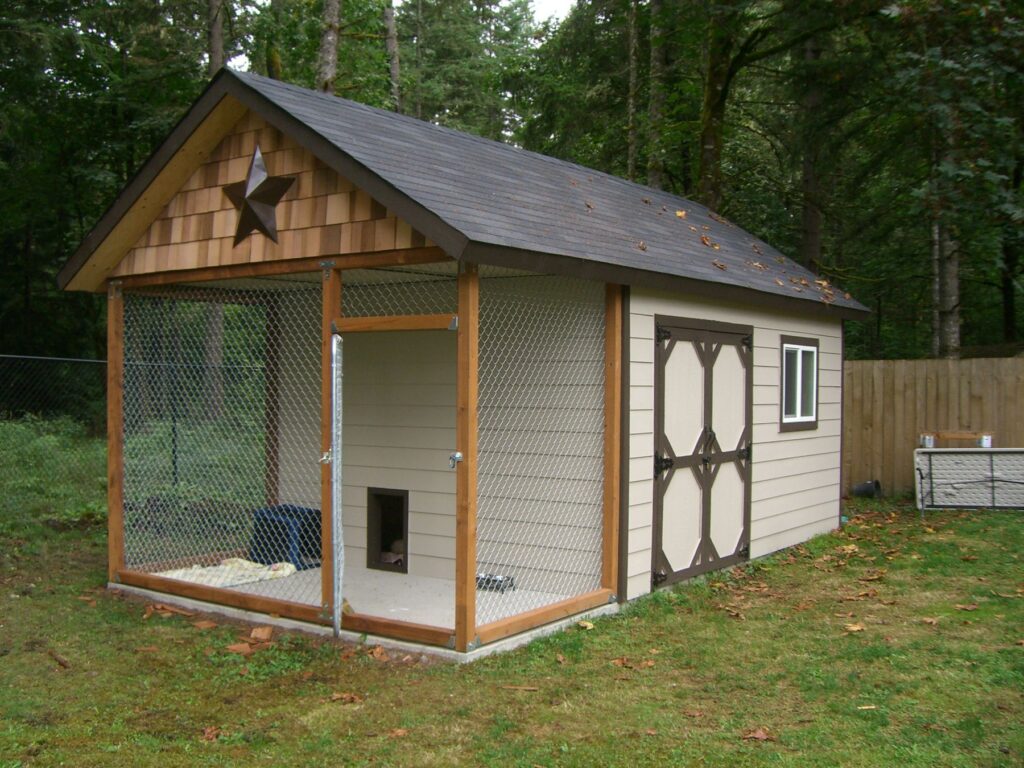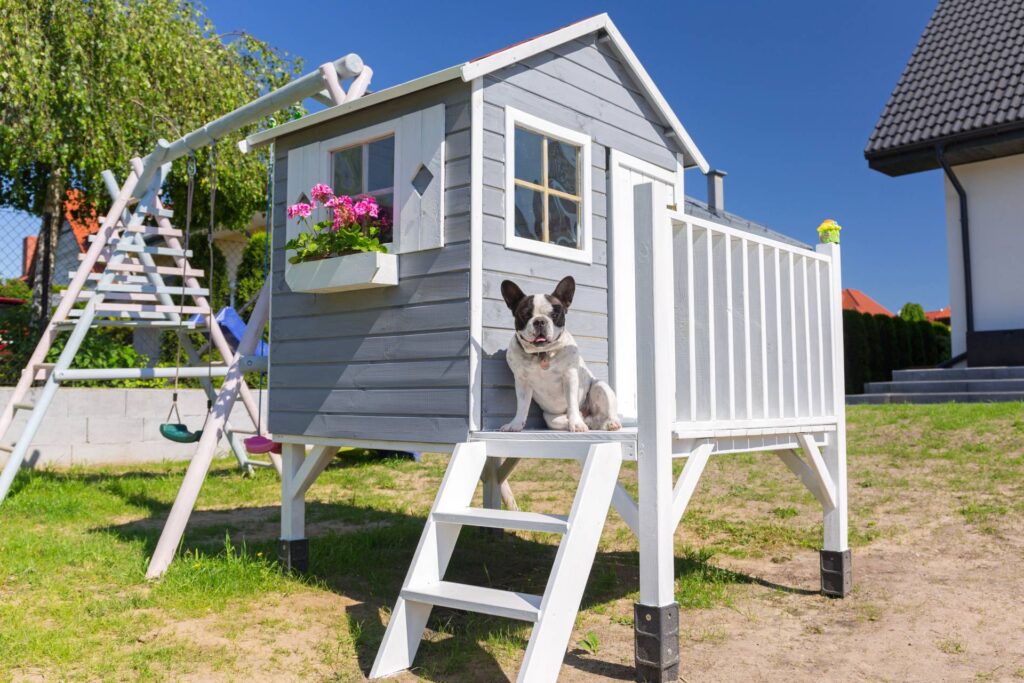Converting a storage shed into a dog house involves several key steps. First, thoroughly clean the shed and ensure it’s safe for your pet by removing any hazards. Consider insulation to regulate temperature extremes and make the space comfortable. Modify the shed’s door to accommodate your dog’s size, potentially adding a doggy door or ramp for easy access. Check and secure windows, ensuring adequate ventilation without direct sunlight exposure. Personalize the interior with a cozy bed, blankets, and toys while organizing essentials like leashes and grooming supplies.
Depending on the climate, consider heating or cooling options to keep your dog comfortable year-round. Additionally, maintain the dog house regularly by cleaning and checking for wear and tear. Always prioritize your dog’s safety and comfort throughout the process, and consult professionals if needed for specific concerns or guidance.
How to prepare a shed for dog house conversion?

Converting a shed into a dog house can be a rewarding project, providing your pet with a comfortable and safe space.
Clearing out the shed and ensuring a clean environment
Clearing out the shed involves removing all existing items, debris, and clutter to create an empty space for the conversion into a dog house. It’s crucial to thoroughly clean the shed, including sweeping or vacuuming the floors, wiping down surfaces, and eliminating any dust, cobwebs, or potential pests. This step creates a fresh canvas for the upcoming modifications and ensures a hygienic environment for your dog.
Assessing the shed for safety hazards and making necessary repairs
Before proceeding further, a detailed inspection of the shed is necessary to identify any safety hazards or potential risks for your pet. This involves checking for sharp edges, protruding nails, loose wiring, or any toxic materials that could harm the dog.
Addressing structural integrity issues, such as weak flooring or compromised walls, is essential. Making necessary repairs promptly ensures a secure and safe space for your pet to inhabit.
Consideration of insulation and its importance for temperature regulation
Insulation plays a critical role in maintaining a comfortable environment inside the dog house. Depending on the climate in your area, insulation helps regulate temperature extremes, keeping the space warm in colder months and cool in hotter seasons.
Different insulation materials like foam boards, fiberglass, or specialized pet-safe insulating materials can be used to ensure a comfortable and consistent temperature, promoting your dog’s well-being and health. Proper insulation also helps in reducing energy costs associated with climate control within the dog house.
What changes are required for converting a shed into a dog house?
Converting a shed into a dog house involves several changes and modifications to make the space suitable and comfortable for your pet.
Door modifications! sizing, installation of a doggy door or ramp
Door modifications involve adapting the shed’s entrance to suit your dog’s needs. This can include resizing the door to accommodate your pet’s size for easy entry and exit. Installing a doggy door or ramp provides convenience and accessibility for your dog.
A doggy door allows your pet to move freely in and out of the dog house, while a ramp aids older or smaller dogs that might struggle with steps, ensuring they can comfortably access their space without difficulty.
Window adjustments for ventilation and natural light
Proper ventilation and natural light are essential for your dog’s well-being. Adjusting windows in the shed helps maintain a fresh airflow, preventing stuffiness and ensuring good air circulation. Pet-friendly screens can be added to prevent insects from entering while allowing fresh air to flow.
Ensuring adequate natural light not only creates a pleasant environment but also helps regulate the dog house’s temperature. Consideration should be given to window size, placement, and materials to ensure optimal ventilation and lighting.
Flooring considerations for comfort and safety
The flooring in the dog house should prioritize both comfort and safety for your pet. Opt for flooring materials that are easy to clean and maintain while providing insulation against cold or dampness. Rubber mats or pet-friendly carpets offer comfort underfoot and insulation from chilly surfaces.
Additionally, ensure the flooring is non-slip to prevent accidents, especially if the dog house might get wet. The flooring should be durable and resistant to scratches or damage caused by your dog’s claws, ensuring a safe and comfortable surface for your pet to move around and rest on.
How to design and furnish a shed for a cozy dog house?

Designing and furnishing a shed to create a cozy dog house involves careful consideration of your pet’s comfort, safety, and needs.
Creating a cozy interior with bedding, blankets, and toys
Designing a comfortable interior involves selecting suitable bedding materials that provide support and insulation. Consider dog beds that are both comfortable and easy to clean. Provide blankets or cushions for additional warmth and coziness, especially in colder climates.
Introducing toys within the space can stimulate mental activity, alleviate boredom, and provide entertainment for your dog while in the dog house. Choosing toys that are safe and durable ensures long-lasting enjoyment for your pet.
Organization of essentials! leashes, grooming supplies, food, and water bowls:
Proper organization of essentials is vital for a functional and orderly dog house. Allocate designated areas or storage solutions for leashes, harnesses, and other walking accessories to maintain tidiness and easy accessibility. Grooming supplies such as brushes, shampoos, and towels should be stored neatly to facilitate grooming sessions.
Place food and water bowls in a designated spot, ensuring a consistent feeding area. Keeping these essentials organized reduces clutter, making the space more comfortable for both you and your dog.
Personalization and customization for the dog’s comfort:
Personalizing the dog house to cater to your pet’s preferences and comfort is key. Consider adding elements that your dog enjoys, such as a favorite blanket or toy. Customize the space based on your dog’s habits and needs, whether it’s additional bedding for extra comfort, a cozy nook for resting, or elevated platforms for lounging.
Adjust the interior layout to match your dog’s size and preferences, ensuring a space that feels safe and secure. Personalization creates a sense of ownership for your pet, fostering a deeper connection with their living space and promoting overall comfort and well-being.
FAQ’s
How to install a floor in a shed?
Installing a shed floor typically involves laying down treated plywood or decking over joists to create a stable and level surface.
How can I cool my shed without electricity?
You can cool a shed naturally by using insulation, proper ventilation, shade-providing plants around the shed, or installing vents to allow airflow.
Can I turn a shed into a summer house?
Yes, with proper modifications like insulation, ventilation, and comfortable furnishings, a shed can be transformed into a cozy summer house.
Can you use a shed as a playhouse?
Absolutely, a shed can be repurposed into a playhouse by making it child-friendly, adding playful elements, and ensuring safety measures.
Can I convert my shed into a garden room?
Yes, converting a shed into a garden room involves insulation, adding windows for natural light, and creating a relaxing space for gardening activities or leisure.
Can you turn a shed into a studio?
Yes, a shed can be transformed into a studio by insulating it for climate control, adding proper lighting, and setting up workstations for creative endeavors.
Final Words
Transforming a storage shed into a dog house involves clearing and cleaning the space, making it safe and cozy for your furry friend. It’s important to assess for safety, adjust doors and windows, and think about insulation to keep your dog comfortable in different weather. Inside, create a snug area with comfy bedding, organize their things neatly, and add personal touches that suit your dog’s preferences.
By doing these steps, you can provide a secure, personalized, and comfortable home for your beloved pet in their new dog house.
